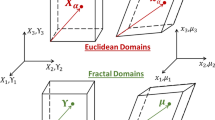Abstract
Based on a self-similar spatial-temporal structure of the relaxation process, we construct a microscopic model for a non-Debye (nonexponential) dielectric relaxation in complex systems. In this model, we derive the Cole-Cole expression for the complex dielectric permittivity and show that the exponent α involved in that expression is equal to the fractal dimension of the spatial-temporal self-similar ensemble characterizing the structure of the medium and the relaxation process occurring in it. We find a relation between the macroscopic relaxation time and the micro- and mesoparameters of the system. We obtain a generalized Cole-Cole expression for the complex dielectric permittivity involving log-periodic corrections that occur because of a discrete scaling invariance of the fractal structure generating the relaxation process on the mesoscopic scale. The found expression for the dielectric permittivity can be used to interpret dielectric spectra in disordered dielectrics.
Similar content being viewed by others
References
Y. Feldman, A. Puzenko, and Ya. Ryabov, “Dielectric relaxation phenomena in complex materials,” in: Advances in Chemical Physics (Y. P. Kalmykov, W. T. Coffey, and S. A. Rice, eds.), Vol. 133, Wiley, New York (2006), p. 1–125.
M. F. Shlesinger, G. M. Zaslavsky, and J. Klafter, Nature, 363, 31–37 (1993).
A. Schönhals, F. Kremer, A. Hofmann, E. W. Fischer, and E. Schlosser, Phys. Rev. Lett., 70, 3459–3462 (1993).
P. Lunkenheimer, A. Pimenov, M. Dressel, Yu.G. Goncharov, R. Bohmer, and A. Loidl, Phys. Rev. Lett., 77, 318–321 (1996).
U. Scheider, P. Lunkenheimer, R. Brand, and A. Loidl, J. Non-Cryst. Solids, 235–237, 173–179 (1998).
H. Fröhlich, Theory of Dielectrics: Dielectric Constant and Dielectric Loss, Oxford Univ. Press, Oxford (1958).
C. J. F. Böttcher and P. Bordewijk, Theory of Electric Polarization, Vol. 2, Dielectrics in Time-Dependent Fields, Elsevier, Amsterdam (1992).
K. S. Cole and R. H. Cole, J. Chem. Phys., 9, 341–351 (1941).
G. Williams, Chem. Rev., 72, 55–69 (1972).
R. H. Cole, “Dielectric polarization and relaxation,” in: Molecular Liquids: Dynamics and Interactions (NATO ASI Series C, Vol. 135, A. J. Barnes, W. J. Orville-Thomas, and J. Yarwood, eds.), Reidel, Dordrecht (1984), pp. 59–110.
R. Kohlrausch, Ann. Phys. (Leipzig), 12, 393 (1847).
G. Williams and D. C. Watts, Trans. Faraday Soc., 66, 80–85 (1970).
A. K. Jonscher, Dielectric Relaxation in Solids, Chelsea Dielectric, London (1983).
A. K. Jonscher, Universal Relaxation Law, Chelsea Dielectric, London (1996).
R. W. Zwanzig, “Statistical mechanics of irreversibility,” in: Lectures in Theoretical Physics (W. E. Brittin, B. W. Downs, and J. Downs, eds.), Vol. 3, Interscience, New York (1961), p. 106–141.
H. Mori, Prog. Theoret. Phys., 34, 399–416 (1965).
J. P. Boon and S. Yip, Molecular Hydrodynamics, McGraw-Hill, New York (1980).
S. G. Samko, A. A. Kilbas, and O. I. Marichev, Integrals and Derivatives of Fractional Order and Some of Their Applications [in Russian], Nauka i Tekhnika, Minsk (1987).
R. R. Nigmatullin, Theor. Math. Phys., 90, 242–251 (1992).
R. R. Nigmatullin and A. Le Mehaute, J. Non-Cryst. Solids, 351, 2888–2899 (2005).
E. Feder, Fractals, Plenum, New York (1988).
V. V. Novikov and V. P. Privalko, Phys. Rev. E, 64, 031504 (2001).
G. P. Johari and M. Goldstein, J. Chem. Phys., 53, 2372–2388 (1970).
G. P. Johari, Ann. NY Acad. Sci., 279, 117–140 (1976).
R. R. Nigmatullin, Phys. B, 358, 201–205 (2005).
R. R. Nigmatullin, Phys. A, 363, 282–298 (2006).
R. R. Nigmatullin, A. A. Arbuzov, F. Salehli, A. Giz, I. Bayrak, and H. Catalgil-Giz, Phys. B, 388, 418–434 (2007).
Author information
Authors and Affiliations
Corresponding author
Additional information
__________
Translated from Teoreticheskaya i Matematicheskaya Fizika, Vol. 173, No. 2, pp. 314–332, November, 2012.
Rights and permissions
About this article
Cite this article
Khamzin, A.A., Nigmatullin, R.R. & Popov, I.I. Microscopic model of a non-Debye dielectric relaxation: The Cole-Cole law and its generalization. Theor Math Phys 173, 1604–1619 (2012). https://doi.org/10.1007/s11232-012-0135-1
Received:
Revised:
Published:
Issue Date:
DOI: https://doi.org/10.1007/s11232-012-0135-1




